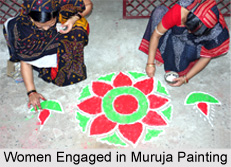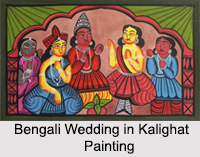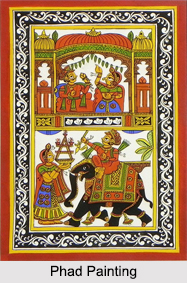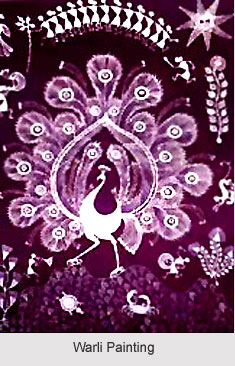 Paitkar paintings of Jharkhand comprise one of the most popular paintings in the state. This mode of painting is a creative expression of the folk art of Jharkhand and the adjacent states. Paitkar Paintings had no demand in the Indian market and international market in the later half of 19th Century. But in recent days, the Paitkar painting gained importance in the national and international markets as there is an enhancement in their art form by the infrastructure given by the Government of Jharkhand. Now the tribal people of Jharkhand are extensively working on this form of art as it gained an exposure in both domestic and foreign markets.
Paitkar paintings of Jharkhand comprise one of the most popular paintings in the state. This mode of painting is a creative expression of the folk art of Jharkhand and the adjacent states. Paitkar Paintings had no demand in the Indian market and international market in the later half of 19th Century. But in recent days, the Paitkar painting gained importance in the national and international markets as there is an enhancement in their art form by the infrastructure given by the Government of Jharkhand. Now the tribal people of Jharkhand are extensively working on this form of art as it gained an exposure in both domestic and foreign markets.
History of Paitkar Painting
The historical lineage of the Paitkar paintings of Jharkhand can be traced to the ethnicity and custom associated with West Bengal. West Bengal is an adjacent state of Jharkhand. The cultural heritage of this old form of painting has associations with one of the popular Hindu Goddesses in the Bengali household called Goddess Manasa. Manasa is the Goddess of Serpents. The village Amadubi situated in the Eastern part of Jharkhand is also called the village of Paitkar. "Paitkar" is the traditional painting of this village, an art form which is present in the village from ancient times. The Paitkar paintings are also popularly known as the scroll paintings of Jharkhand. This painting form is popular in West Bengal, Bihar, Odisha and other adjacent states of India.
Features of Paitkar Painting
The Paitkar paintings of Jharkhand have links with the socio-religious custom of holding yajnas and giving alms to the different Hindu Gods and Goddess and even the tribal Gods of Jharkhand. The Paitkar paintings are also popularly known as the scroll paintings of Jharkhand. This painting is popular in West Bengal, Bihar, Odisha and other adjacent states of India. The form of painting has got its name from its character. The paintings that belong to this school have a common subject of what happens to human life after death. While on the contrary, this scroll painting also mirrors the Bengali and Jharkhandi daily life.
The medium through which the Paitkar artists use to paint their scrolls in water-based colours is derived from nature. The colour palette of Chitrakars (artists) consists of fewer colours. They collect only primary colours like Red, Yellow and Blue, from the nature.
Human characters occupy most part of the painted space. These characters are present in profile and sometimes in semi profile. The eyes are elongated which reflects the characteristic of Indian painting style. The painted face came much later only in the mid-20th century. Spontaneous lines drawn by Paitka have an angularity, and anatomical details are not very defined.
Themes of Paitkar Painting
Paitkar painting are mostly associated with Hindu epics. The stories are from Ramayana, Mahabharata, Manasa song (Manasa pada), Kali song (Kali Pada). Ramayana story focuses on the character drawings of Rama, Sita and Mandudari. They recount the story about the deeds of Gods and Goddesses, such as Shiva or Durga from Hindu mythology; or the local deities, such as the snake goddess Manasa.
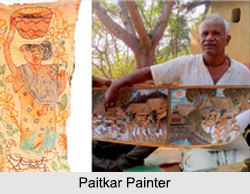 Famous Paitkar Paintings
Famous Paitkar Paintings
The usual subjects or contents of Paitkar painting are fairs and festivals, mythology, social life, Traditional Hindu epic such as Ramayana and Mahabharata, popular legend and folk tale, Flora and fauna etc. The fieldworks have provided the religious links to Paitkar and helped to look at the religious connection to their livelihood. Paitkar paintings are mostly associated with Hindu epics. Ramayana, Mahabharata, Manasa mangal, Durga Pada, Kali Pada, Data Karna, Nouka Vilash are in Paitkar artist"s repertory.
Ramayana story focuses on the character drawing Rama, Sita and Mandudari. They lso recount the story about the deeds of Gods and Goddesses, such as Shiva or Durga, from Hindu mythology; or the local deities, such as the snake goddess Manasa. The land of Jharkhand area has huge cavity and snakes loves to reside in this cavity. And the painters who are in search of dye and natural colour get scared to take it out in between the soils and stones because of it. The snake deity Manasa is believed to be protector from snake bites as well as bringing prosperity to the family in this area. That"s why they worship the snake goddess Manasa and depict her story in Paitkar.
Techniques of Paitkar Painting
Till date Paitkar artists are not trying any commercial colours in their painting. The artist uses certain leaves, coloured stone and soil to prepare colour. The soil and colour stone are available by the riverside. But it is tiresome to find them. For the colour preparation, at first they grind leaf and fruits and make a paste. Then take out the liquid part from the paste and pour some water in a certain proportion. After that boil this liquid and filter the concoction. And for making this liquid more thick, the artist boils it again.
They collect coloured stones, soil, vegetables and leaves from their surroundings. They grind it with water on a plain stone surface. When the mixture is completed they remove the dust from it with a strainer and boil it to make it thicker. The Paitkar artists use a natural gum with the colours to make it permanent and give more glazes. This natural gum is collected from bel (wood apple) fruit and the resin of neem tree. The black colour is made up of the smoke of kerosene lamp. Kerosene lamp creates black smoke and Paitkar artist store the clinker or carbon residue from the black smoke and then mix it with the natural gum and water.
The tribal people of Jharkhand have not been able to spread the name of their creations far and wide. Particularly, the Paitkar paintings of Jharkhand might suffer a massive setback and in near future, it might transform into a form of painting that once existed. But the local government is now stressing on this art form to develop the commercial basis of the tribal people of Jharkhand.

